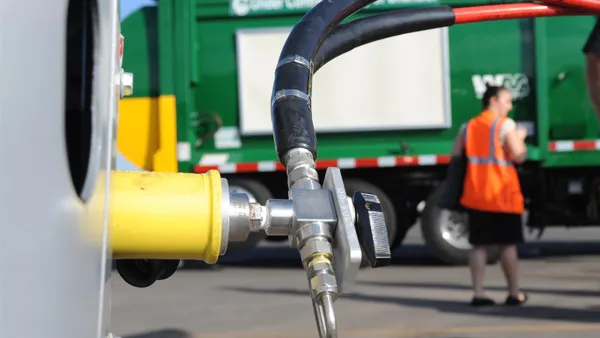UPDATE: June 19, 2019: The Oregon Senate has approved a bill (SB451) designating incineration as a renewable energy source, as reported by the Statesman Journal. The bill, which exempts the Covanta Marion incinerator from Oregon's cap-and-trade bill, was buttressed by support from the company — Marion County's disposal costs, Covanta warned lawmakers, would more than double without the designation. Furthermore, the plant's future would be in question, jeopardizing 33 union jobs.
"I think this bill would have my nomination for most persistent lobbyist effort of the session," said Sen. Jeff Golden, adding that Oregon "will stand alone on the West Coast in valuing garbage incineration as a source of clean power."
According to Sen. Herman Baertschiger, Covanta's renewable energy credits — worth several million dollars — will help the company implement upgrades and maintenance programs. The bill now awaits a vote in the House.
Dive Brief:
- Oregon lawmakers unveiled on Monday an extensive set of amendments to the state's cap-and-trade bill, as reported by OPB. Included in the package is the removal of carbon cap exemptions previously granted to incinerators built before 1995 — a description that applies solely to a Covanta-operated incinerator in Marion County.
- HB 2020, which aims to drastically reduce Oregon's greenhouse gas emissions by 2050, would apply directly to approximately 100 companies, making Oregon the second state after California to implement an economy-wide cap-and-trade system.
- The nixed exemption represents the latest proposed legislation taking aim at incinerator subsidies. A new carbon fee proposal in New York would impact four sites run by Covanta — three of which it owns — according to Newsday, while the Maryland Senate voted last week to strip incinerators, including one Covanta-operated site, of their "green energy" label, as reported by the Baltimore Sun.
Dive Insight:
HB 2020, an iteration of last year's Clean Energy Jobs bill, marks Oregon lawmakers' latest attempt to achieve statewide climate emissions reduction targets. Backed by Gov. Kate Brown and other Democratic leaders, the bill would set a cap on emissions starting in 2021, requiring entities emitting more than 25,000 metric tons of carbon dioxide equivalent to purchase "allowances" for each ton emitted annually. Over time, the state would decrease the cap and number of allowances, with the goal of eventually hitting 2035 and 2050 carbon pollution benchmarks.
The proposed amendment package includes a number of crucial changes, including:
-
Eliminating the Covanta Marion exemption. A campaign by environmental advocates last fall put the incinerator back on the chopping block: Covanta Marion is the state's 20th largest GHG emitter, according to the Oregon Department of Environmental Quality, with 160,844 metric tons of carbon dioxide equivalent emitted in 2017. Intel and other semiconductor manufacturers are also now subject to carbon caps under the new amendment.
-
Fuel rebates. In an effort to assist low-income Oregonians in the transition, the new bill would refund up to $100 million annually in state revenues to households earning less than the area median income.
-
New credit giveaway scheme. While the original bill granted GHG emitters in certain industries 100% free credits in 2021, the amendment package proposes 95% free credits for the first three years of the program. Facilities would receive the same deal in subsequent years for using the "best available technology" — technology that "will most efficiently reduce the greenhouse gas emissions associated with the manufacture of a good" — in their industry. However, emitters using inefficient technology — and thus theoretically generating emissions above the state-established benchmark — would be forced to pay more.
-
Specific program beneficiaries. The package identifies rural communities, low-income communities and federally recognized tribes as beneficiaries of a prescribed percentage of spending from the program; it also prioritizes investments in wildfire prevention and job training.
The removal of the incinerator exemption is a potential blow to Covanta, which donated more than $21,000 in campaign contributions last fall to state elected officials, as reported by the Portland Tribune. The company earned $10.3 million last year from its contract with Marion County.
"The waste sector should be treated equitably," James Regan, Covanta's media relations director, told Waste Dive. "Exclusion of waste-to-energy in cap-and-trade programs is consistent with the approach the EU took with their emission trading program."
"Inclusion in the program could disincentivize the only source of electricity with a negative greenhouse gas footprint," he added.
While HB 2020 enjoys support from Democratic supermajorities in both the House and Senate, it continues to face opposition from Republicans concerned about potential fiscal implications — many of whom have submitted their own amendments to the legislation in recent weeks.
Covanta Marion may also be getting another shot at circumventing Oregon’s carbon legislation. A company-supported bill (SB451) seeks to reclassify the incinerator as a renewable energy plant — a move strenuously opposed by the state's leading environmental groups and many citizens.
"It is hard to conceive," testified Rhett Lawrence, conservation director of the Sierra Club's Oregon Chapter, at the bill's recent public hearing, "How the burning of household garbage — including plastics and other even more potentially toxic substances — can be considered a renewable energy source."











